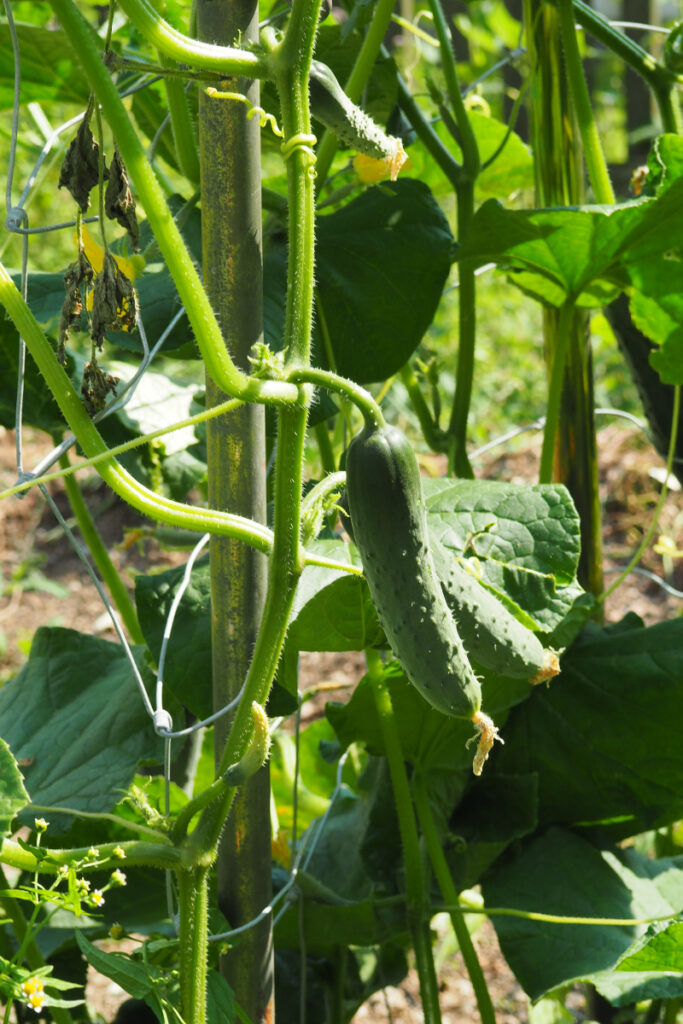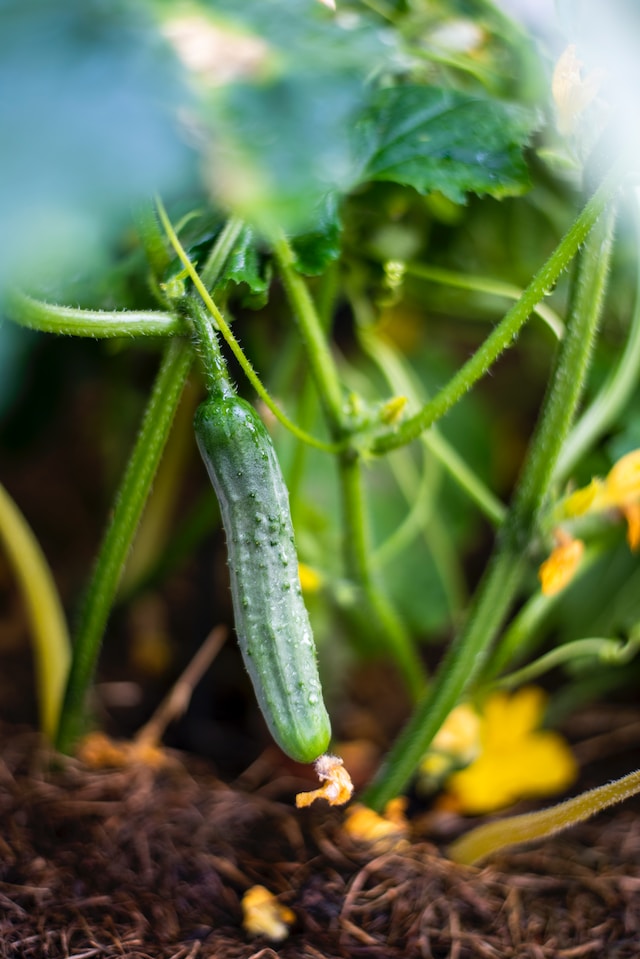Florida’s Ultimate Cucumber Growing Guide
Growing cucumbers in Florida has always been a challenge due to the state’s hot and humid climate. However, with the right knowledge and techniques, anyone can raise a bountiful crop of crisp cucumbers any time of year.
If you are looking for an easy way to start growing your own cucumbers in Florida, read on for our comprehensive guide & thrive in the cucumber cultivation adventure!

Choosing the Right Cucumber Variety
Florida’s unique climate and growing conditions mean that not all cucumber varieties will thrive here. To ensure success in your garden, it’s essential to choose the right type of cucumber to grow. Here are some of the best cucumber varieties for Florida:
Straight Eight
This classic slicing cucumber is known for its straight, uniform shape and excellent flavor. It’s a reliable choice for Florida gardens, as it’s resistant to common cucumber diseases.
Marketmore 76
Another great slicing cucumber, Marketmore 76 is a high-yielding variety with dark green, uniform fruits. It’s resistant to powdery mildew and cucumber mosaic virus, making it a durable option for Florida growers.
Diva
This hybrid cucumber variety is known for its sweet, tender flesh and thin skin. Diva cucumbers are also resistant to several common diseases, including downy mildew and powdery mildew, which can be prevalent in Florida’s humid climate.
Picklebush
If you’re interested in growing cucumbers for pickling, Picklebush is an excellent choice. This compact, bush-type plant produces an abundance of small, crisp cucumbers that are perfect for pickling.
Armenian
Also known as the snake melon or serpent cucumber, this unique variety has a mild, slightly sweet flavor and a crunchy texture. It thrives in hot climates like Florida and can be eaten fresh or used in salads and other dishes.
When deciding which type of cucumber to grow, consider your personal preferences and how you plan to use your cucumbers. If you’re a fan of fresh salads, then a slicing cucumber like Straight Eight or Marketmore 76 might be ideal.
If you love pickles, then a pickling variety like Picklebush is the way to go. And if you’re looking for something a little different, try growing Armenian cucumbers for a unique addition to your garden.
Preparing Your Garden
To give your cucumbers the best chance at success, it’s crucial to prepare your garden with care. Here are some essential steps for getting your Florida garden cucumber-ready:
Soil Requirements for Cucumbers
Cucumbers prefer well-draining, fertile soil with a pH between 6.0 and 6.8. Sandy loam is ideal, as it provides good drainage and retains enough moisture to keep your plants happy.
If your soil is heavy clay or too sandy, consider amending it with organic matter like compost or well-rotted manure to improve its structure and fertility.
Raised Beds vs. In-Ground Planting
In Florida, raised beds can be an excellent choice for growing cucumbers, as they offer improved drainage and help prevent soil-borne diseases.
Raised beds also allow you to better control the quality of your soil, which can be especially helpful if you’re dealing with sandy or nutrient-poor native soil.
However, in-ground planting is also an option if you have well-draining soil and are diligent about disease prevention. Just be sure to choose a sunny spot in your garden, as cucumbers need at least 6-8 hours of sunlight per day to thrive.
Tips for Planting Cucumbers
- Start seeds indoors about 3-4 weeks before your last expected frost date, or sow seeds directly into the garden once the soil temperature reaches 60°F (15°C). If starting indoors, use biodegradable pots to minimize transplant shock.
- Space cucumber plants about 12-24 inches apart, depending on the variety. Rows should be spaced 3-4 feet apart, allowing ample room for growth and airflow.
- If using trellises or other supports, install them at the time of planting to avoid disturbing the roots later on. Vertical growing can save space and help prevent diseases by keeping the fruits off the ground.

Caring for Your Cucumber Plants
Once your cucumbers are planted, proper care is essential to ensure a bountiful harvest. Here are some tips for keeping your cucumber plants healthy and productive:
Watering and Fertilizing Tips
Cucumbers need consistent moisture, so aim to provide about 1-2 inches of water per week, either through rainfall or supplemental watering. Be sure to water at the base of the plant to reduce the risk of leaf diseases.
Use a balanced, all-purpose fertilizer when planting, and then side-dress with a nitrogen-rich fertilizer every 3-4 weeks during the growing season. Avoid over-fertilizing, as this can lead to excessive vine growth at the expense of fruit production.
Managing Pests and Diseases
Common pests like aphids, cucumber beetles, and spider mites can be controlled with insecticidal soap, neem oil, or other organic pest control methods. Regularly inspect your plants for signs of infestation and take action promptly.
To prevent diseases, practice good garden hygiene by removing plant debris and weeds, which can harbor pathogens. Rotate your crops each year to avoid building up disease pressure in the soil.
If you notice signs of disease, such as yellowing leaves, wilting, or unusual spots, promptly remove and dispose of the affected plant material to prevent the spread of disease.
Pruning and Training Your Cucumber Plants
Prune away any dead or diseased leaves and vines to improve air circulation and reduce the risk of disease. If you’re growing your cucumbers vertically, train the vines to climb the trellis or support by gently wrapping them around the structure or using soft ties to secure them in place.
For bush-type cucumber plants, consider pinching off the growing tips after they’ve reached a certain size to encourage lateral growth and increased fruit production.
Harvesting and Storing Cucumbers
Knowing when to harvest your cucumbers and how to store them properly will ensure that you enjoy the fruits of your labor for as long as possible. Here are some tips for harvesting and storing your Florida-grown cucumbers:
When to Harvest Cucumbers
Harvest time depends on the variety and desired use of your cucumbers. Generally, slicing cucumbers should be picked when they’re 7-9 inches long, while pickling cucumbers should be harvested when they’re 3-4 inches long.
Check your cucumber plants daily, as cucumbers can grow quickly and become overripe if left on the vine too long. Overripe cucumbers may become bitter and have a tough skin.
To harvest, use a sharp knife or pruning shears to cut the cucumber from the vine, leaving a short stub of stem attached. Avoid pulling or twisting the fruit, as this can damage the plant.
Proper Cucumber Storage Techniques
After harvesting, gently wash your cucumbers to remove any dirt or debris, then dry them thoroughly with a clean cloth or paper towel.
Store cucumbers in the refrigerator at temperatures between 45°F and 50°F (7°C and 10°C) to slow down the ripening process. Avoid storing them in the coldest part of the fridge, as freezing temperatures can cause damage to the texture and flavor.
Keep cucumbers in a plastic bag or container with a few small air holes to maintain humidity, but prevent excess moisture buildup, which can lead to rotting.
Use your stored cucumbers within a week for the best quality and flavor. If you’ve grown more cucumbers than you can eat fresh, consider preserving them through pickling or other methods.
Frequently Asked Questions
If you’re living in Florida and would like to grow cucumbers in your garden, here are some answers to frequently asked questions:
Q: What time of year can you grow cucumbers in Florida?
A: Cucumbers can be planted in Florida from late winter through early summer, when temperatures are warm and no longer frost-prone. Make sure to check your local climate zone for the best planting times based on your specific location.
Q: Do cucumbers grow year round in Florida?
A: Cucumbers are a warm weather crop, so they can only be grown in Florida during the spring and summer months. Cooler temperatures in late fall and winter can cause your cucumber plants to become stunted and produce fewer fruits.
Q: Can I grow cucumbers in South Florida?
A: Absolutely! Cucumbers are ideal for warm climates, and South Florida is no exception. You can plant your cucumber seeds directly in the ground once the temperature reaches 60°F (15°C) and enjoy a plentiful crop before the temperatures become too hot. Be sure to pay close attention to watering requirements during the dry summer months.
Q: How long does it take to grow cucumbers in Florida?
A: Cucumbers typically take 50-70 days to mature, depending on the variety. Generally, slicing cucumbers require more time to reach maturity than pickling cucumbers.
Make sure to check the seed packet for the estimated days to harvest of your chosen variety before planting.
Q: Why did my cucumbers wither?
A: This can be due to a variety of factors, including too little or too much water, poor soil fertility, excessive heat or cold temperatures, lack of pollination, or disease.
Make sure to check your cucumber plants regularly and take action promptly if you notice any signs of distress.
Excessively wilted cucumbers may not recover, so remove them from the plant and dispose of them properly to avoid spreading any diseases.
Your Takeaway
Florida offers an ideal climate for growing cucumbers. With the right knowledge and care, you can enjoy a bounty of fresh cucumbers from your own backyard!
Start by selecting a variety that’s well-suited to the Florida climate, prepare the soil with compost or other organic amendments, and pay close attention to irrigation requirements throughout the season.
Regularly inspect your plants for signs of pest or disease activity and take action promptly if necessary. When cucumbers are ready to harvest, store them properly in the refrigerator to prevent spoilage.
With a little bit of effort, you can enjoy fresh Florida-grown cucumbers all season long without ever having to step foot in the grocery store!
Grow Something Else in Florida
Florida’s climate is not limited to cucumbers! There are a wide variety of vegetables and fruits that you can grow in your Florida garden.
If you’d like to try something different, consider eggplant, squash, tomatoes, peppers, okra or even tropical fruits such as mangoes or bananas. With the right preparation and care, these crops can thrive in the Florida: